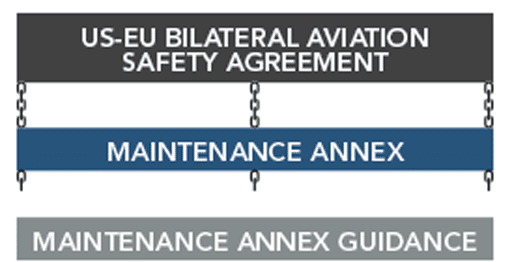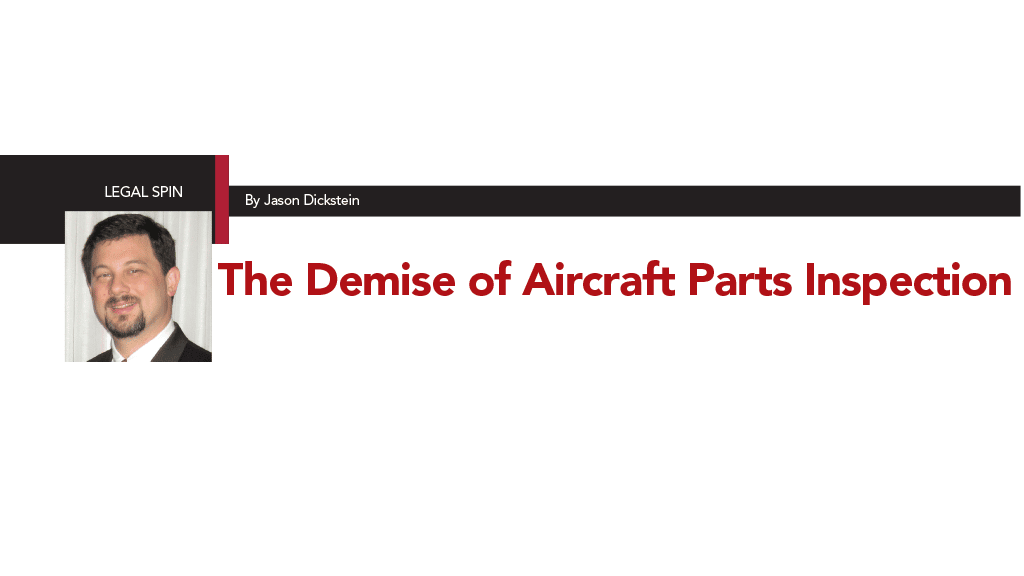We often joke about the paperwork being more important than the parts. I’ve seen washers where the paperwork package really was thicker than the part. But this summer the FAA took steps to cement its reliance on documentation over analysis.
This summer, the FAA cancelled E-100, which was the ARSA-published process for inspecting parts to ensure that they conform to expected airworthiness conditions. This was really an extension of the obligation described in 14 CFR 43.13(b), which requires that the maintainer “use materials of such a quality, that the condition of the … appliance worked on will be at least equal to its original or properly altered condition.” That regulation permits US-based repair stations to use reasonable means for determining the airworthiness of the parts and materials that will be used. FAA Chief Counsel’s opinion letters have admitted that relying on documentation is one way but not the only way to determine airworthiness of an aircraft part.
This is different from the European aviation system, which relies on parts documentation. All production approval holders are required to issue EASA Form One for new parts. So all approved aircraft parts get a birth record in the form of an EASA Form One. And this means that all repair stations can look for the EASA Form One when they get a new European part entering their receiving inspection system.
The FAA system is neither better nor worse. It is simply different.
The reason that E-100 was needed, though, was related to the FAA-EASA agreements that permit US-based repair stations to seek EASA-145 certificates. One of the documents – the Maintenance Annex Guidance – says that parts from U.S. production approval holders must be received with an FAA 8130-3 tag (there is no exception for parts required to be marked by the manufacturer, like PMA and TSOA parts, even though the FAA regulates those markings just as strongly as they regulate the 8130-3 tag).
The hierarchy of these agreements looks like this:

Notice that there is no direct connection between the Maintenance Annex and the Maintenance Annex Guidance in this illustration. That’s because the original terms and conditions did not anticipate using additional guidance as a way to impose additional restrictions that were not included in the Agreement and Annex.
The bilateral agreement and its Maintenance Annex were adopted into the European legal system by the Council of the European Union. This makes it very difficult to change, unless you go back to the EU itself (that is, EASA cannot change these documents by itself). The Maintenance Annex Guidance is signed by the leaders of the Flight Standards Services of FAA and EASA, so they have the discretion to change it at will. Here’s the reason that the disconnect between the signed bilateral agreements and the Maintenance Annex Guidance is important: the Maintenance Annex Guidance does not follow the logic of the Bilateral Agreement.
To understand how the logic of the Maintenance Annex Guidance and the Bilateral Agreement differ, let’s start by examining how the bilateral agreement deals with difference between the US and EU systems.
The bilateral aviation safety agreement between the United States and the European Union does not recognize that the two systems are identical. In fact, it does the opposite. It recognizes that the two systems are “sufficiently compatible.” It specifically recognizes that are technical differences between the systems of Europe and the United States. But it finds that a “repair station shall be issued an EASA certificate” if it meets three conditions:
1) The FAA has issued a repair station certificate to the entity under the FAA’s regulations;
2) The repair station complies with the conditions set forth in the Maintenance Annex (including the EASA Special Conditions);
3) The FAA issues a recommendation for approval to EASA
Under this three part test, the EASA Special Conditions are extremely important because they reflect the difference in the systems that EASA has said are important, and that the US repair station applicants need to follow in order to obtain EASA 145 certification.
The United States regulations do not require specific paperwork as a condition for receiving aircraft parts into the repair station’s system; so the obvious question is whether the European documentation requirements are included among the EASA Special Conditions that are published in the Maintenance Annex.
They are not.
There is a list of things that must be in the EASA supplement to the repair station manual. The only documentation requirement is one that requires that components be released on an 8130-3 tag when the repair station completes the maintenance. But nothing in the Maintenance Annex requires that parts that are received must include 8130-3 tags.
The requirement for US-based repair stations to look for particular documentation when receiving parts is found in a document called the Maintenance Anne Guidance (also known as the “MAG”). This MAG adds the receiving documentation requirements that were left out of the Maintenance Annex.
The real problem with all of this? First of all there is a safety problem: It is easier to make counterfeit paperwork than it is to make counterfeit parts. By training repair station personnel to rely exclusively on the paperwork as the primary inspection point, we close off an important safety valve in our system – the ability to examine parts and make an independent determination about airworthiness.
Second, we are also closing our doors to good parts. Many aircraft parts in inventories today were released without an 8130-3 tag. We still encounter production approval holders that release parts without the 8130-3 tag. The parts you receive may have been released on a manufacturer’s certificate of conformity or a similar document. You might be able to obtain complete back-to-birth traceability that shows that the part was produced by a U.S. production approval holder; but the requirement for an 8130-3 tag inhibits acceptance of certain parts that can be otherwise identified as safe.
Third, the documents are simply records that someone else performed an airworthiness analysis. This should not negate a direct inspection when it can be performed by the installer.
One of the valuable features of the ARSA E-100 process was that it outlined inspections that could be performed on parts to confirm their airworthiness, including ways to confirm that the part was released by a production approval holder. Such airworthy parts are 100% acceptable under the FAA regulations. But the fact that they are missing the right piece of paper means that a repair station cannot accept the same (otherwise airworthy) part under their EASA approval.
So what does this mean for US-based repair stations with EASA credentials? Most of you will be able to obtain all the parts you need with 8130-3 tags, because we have actively encouraged US production approval holders to issue 8130-3 tags. But a few of you will have troubles. Those of you who are able to obtain FAA-approved parts, but are having trouble getting them with 8130-3 tags, will likely need to seek out other mechanisms for obtaining 8130-3 tags in order to bring those parts into your system. The FAA Designated Airworthiness Representative (DAR) system is a potential source of 8130-3 tags for demonstrably airworthy parts, and this system is even more important with the retirement of E-100. If you rely on U.S.-based manufacturers who do not issue 8130-3 tags, then please let them know how important it is for them to issue those tags. And of course, if you are obtaining parts that are not produced by production approval holders, then you will need to make sure that they fit into some recognized exception that permits them to be received and used.
